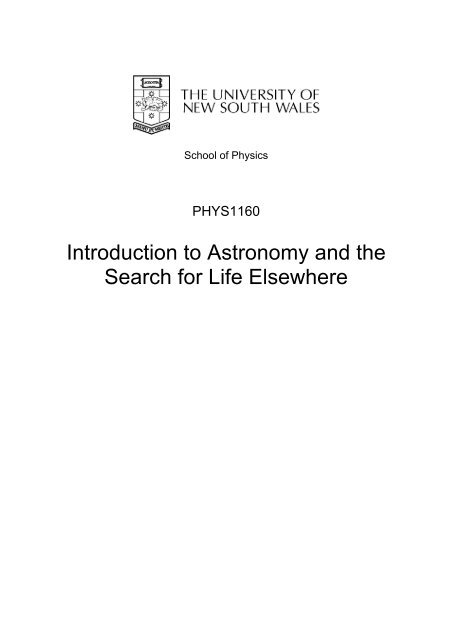Introduction to Astronomy and the Search for Life ... - School of Physics
Introduction to Astronomy and the Search for Life ... - School of Physics
Introduction to Astronomy and the Search for Life ... - School of Physics
You also want an ePaper? Increase the reach of your titles
YUMPU automatically turns print PDFs into web optimized ePapers that Google loves.
<strong>School</strong> <strong>of</strong> <strong>Physics</strong><br />
PHYS1160<br />
<strong>Introduction</strong> <strong>to</strong> <strong>Astronomy</strong> <strong>and</strong> <strong>the</strong><br />
<strong>Search</strong> <strong>for</strong> <strong>Life</strong> Elsewhere
PHYS1160 — Modules<br />
Module 1 — <strong>Introduction</strong><br />
Lecture 1 — <strong>Introduction</strong> <strong>to</strong> <strong>Astronomy</strong><br />
The components <strong>of</strong> <strong>the</strong> universe (stars, planets <strong>and</strong> galaxies), <strong>the</strong><br />
scale <strong>of</strong> <strong>the</strong> universe, a brief his<strong>to</strong>rical guide <strong>to</strong> <strong>the</strong> study <strong>of</strong><br />
astronomy.<br />
Lecture 2 — <strong>Introduction</strong> <strong>to</strong> Astrobiology<br />
Why life might be common, or might be rare. The science <strong>of</strong><br />
astrobiology. Where <strong>and</strong> how can we search <strong>for</strong> life in <strong>the</strong> universe?<br />
Lecture 3 — Key Concepts<br />
Gravity, orbits <strong>and</strong> Kepler’s laws. A<strong>to</strong>ms <strong>and</strong> nuclei. Light <strong>and</strong> o<strong>the</strong>r<br />
electromagnetic waves. Spectra <strong>and</strong> <strong>the</strong> Doppler shift.<br />
Lecture 4 — Techniques <strong>of</strong> <strong>Astronomy</strong><br />
Telescopes <strong>and</strong> instruments <strong>for</strong> different wavelength regions.<br />
Observing methods. Effect <strong>of</strong> <strong>the</strong> atmosphere. Observations from<br />
space.<br />
Module 2 — The Solar System<br />
Lecture 5 — The Solar System<br />
<strong>Introduction</strong> <strong>to</strong> <strong>the</strong> solar system. Terrestrial <strong>and</strong> giant planets,<br />
satellites, dwarf planets., small solar system bodies. The <strong>for</strong>mation<br />
<strong>of</strong> <strong>the</strong> solar system.<br />
Lecture 6 — The Earth – Evolution <strong>of</strong> a habitable planet<br />
Formation <strong>of</strong> <strong>the</strong> Earth <strong>and</strong> Moon. Age <strong>of</strong> <strong>the</strong> Earth. The heavy<br />
bombardment. Plate tec<strong>to</strong>nics. Formation <strong>of</strong> oceans <strong>and</strong> continents.<br />
Evolution <strong>of</strong> <strong>the</strong> atmosphere. The faint-young Sun paradox <strong>and</strong> its<br />
resolution.<br />
Lecture 7 — Exploring <strong>the</strong> Solar System<br />
Getting <strong>to</strong> a planet. Types <strong>of</strong> space missions. The key planetary<br />
exploration mission <strong>and</strong> what we have learnt from <strong>the</strong>m. Groundbased<br />
studies <strong>of</strong> <strong>the</strong> planets.<br />
Lecture 8 — Habitability in <strong>the</strong> Solar System<br />
Definition <strong>of</strong> a habitable planet. Follow <strong>the</strong> Water. Past water on<br />
Venus. Evidence <strong>for</strong> water on Mars in <strong>the</strong> past <strong>and</strong> now. Evidence<br />
<strong>for</strong> oceans beneath <strong>the</strong> ice <strong>of</strong> Jupiter’s moons <strong>and</strong> Enceladus.<br />
2
Module 3 — <strong>Life</strong> on Earth <strong>and</strong> in <strong>the</strong> Solar System<br />
Lecture 9 — What is <strong>Life</strong>?<br />
Properties <strong>of</strong> life. Classification <strong>of</strong> living organisms, Evolution <strong>and</strong><br />
heredity. The molecular basis <strong>for</strong> life, DNA, RNA <strong>and</strong> proteins.<br />
Lecture 10 — The His<strong>to</strong>ry <strong>of</strong> <strong>Life</strong> on Earth<br />
Methods <strong>for</strong> studying life’s his<strong>to</strong>ry. The fossil record. The earliest<br />
evidence <strong>for</strong> life. Molecular methods <strong>and</strong> <strong>the</strong> “tree <strong>of</strong> life”.<br />
Extremophiles. <strong>Life</strong> <strong>and</strong> <strong>the</strong> Earth’s atmosphere.<br />
Lecture 11 — The Origin <strong>of</strong> <strong>Life</strong><br />
His<strong>to</strong>rical ideas on life’s origin. The fundamental problem. The RNA<br />
World. Possible pre-RNA worlds. Origin <strong>of</strong> <strong>the</strong> building blocks <strong>of</strong> life.<br />
The timing <strong>of</strong> life’s origin relative <strong>to</strong> <strong>the</strong> late heavy bombardment.<br />
Could life have come from ano<strong>the</strong>r planet?<br />
Lecture 12 — <strong>Life</strong> in <strong>the</strong> Solar System<br />
Ideas on life on Mars. Percival Lowell’s canals. Early Mars missions.<br />
The Viking missions. The martian meteorite ALH84001. Methane on<br />
Mars, Future Mars missions. <strong>Life</strong> on <strong>the</strong> giant planet moons <strong>and</strong> how<br />
we could search <strong>for</strong> it.<br />
Module 4 — Stars<br />
Lecture 13 — Our Star, <strong>the</strong> Sun<br />
The Sun’s energy source. Nuclear fusion. Structure <strong>of</strong> <strong>the</strong> Sun.<br />
Solar activity. The Sun-Earth connection.<br />
Lecture 14 — Properties <strong>and</strong> Evolution <strong>of</strong> Stars<br />
Properties <strong>of</strong> stars. Spectroscopic classification. The Hertzprung-<br />
Russell diagram. Types <strong>of</strong> stars. Evolution <strong>of</strong> low <strong>and</strong> high mass<br />
stars. Multiple stars. Star clusters.<br />
Lecture 15 — Stellar Birth <strong>and</strong> Death<br />
The interstellar medium. Molecular clouds. Star <strong>for</strong>mation. Planetary<br />
nebulae. White Dwarfs. Supernovae. Neutron stars <strong>and</strong> black holes.<br />
Module 5 — O<strong>the</strong>r Worlds<br />
Lecture 16 — Extrasolar Planets<br />
Detection <strong>of</strong> exoplanets. Doppler, transit, microlensing methods.<br />
Types <strong>of</strong> <strong>and</strong> properties <strong>of</strong> exoplanets (e.g. hot Jupiters, eccentric<br />
planets). Comparison with our solar system.<br />
Lecture 17 — Habitability <strong>and</strong> life on exoplanets<br />
The problem <strong>of</strong> directly detecting exoplanets. Direct detection<br />
methods (giant ground-based telescope. nulling inerferometers,<br />
coronographs, Occulters). Signatures <strong>of</strong> habitability. Biosignatures.<br />
3
Lecture 18 — The <strong>Search</strong> <strong>for</strong> Extraterrestrial Inteliigence (SETI)<br />
Brief his<strong>to</strong>ry <strong>of</strong> SETI. The Drake Equation. Radio SETI techniques.<br />
SETI at optical <strong>and</strong> o<strong>the</strong>r wavelengths. Messages <strong>to</strong> <strong>the</strong> Stars. The<br />
Fermi Paradox.<br />
Module 6 — Galaxies <strong>and</strong> Cosmology<br />
Lecture 19 — Our Milky Way Galaxy<br />
Size <strong>and</strong> structure <strong>of</strong> <strong>the</strong> Milky Way. The disk, bulge <strong>and</strong> halo. Orbits<br />
<strong>of</strong> stars. Gas in <strong>the</strong> galaxy <strong>and</strong> recycling <strong>of</strong> gas. The galactic centre.<br />
Lecture 20 — Galaxies <strong>and</strong> <strong>the</strong>ir Evolution<br />
Types <strong>of</strong> galaxies. Distances <strong>of</strong> galaxies. Looking back in time. The<br />
Hubble deep field. Galaxy <strong>for</strong>mation <strong>and</strong> evolution. Active galaxies<br />
<strong>and</strong> quasars.<br />
Lecture 21 — Cosmology<br />
The exp<strong>and</strong>ing universe <strong>and</strong> Hubble’s law. The Big Bang <strong>the</strong>ory.<br />
The cosmic microwave background. Dark matter <strong>and</strong> <strong>the</strong> evidence<br />
<strong>for</strong> it. The accelerating universe <strong>and</strong> dark energy, The st<strong>and</strong>ard<br />
model <strong>of</strong> <strong>the</strong> universe.<br />
Resources <strong>for</strong> students<br />
• The course textbook is “The Cosmic Perspective”, Bennett, Donahue,<br />
Schneider <strong>and</strong> Voit, 5 th Edition, Pearson/Addison Wesley.<br />
• A recommended additional book is “<strong>Life</strong> in <strong>the</strong> Universe”, Bennett <strong>and</strong><br />
Shostak, 2 nd Edition, Pearson/Addison Wesley, which gives more details on<br />
<strong>the</strong> Astrobiology aspects <strong>of</strong> <strong>the</strong> course.<br />
• Interactive tu<strong>to</strong>rials, interactive figure, quizzes <strong>and</strong> o<strong>the</strong>r material are<br />
available on <strong>the</strong> Pearson Mastering <strong>Astronomy</strong> site.<br />
• Links <strong>to</strong> additional material on <strong>the</strong> web will be provided on <strong>the</strong> Blackboard<br />
site.<br />
4
















